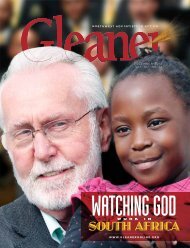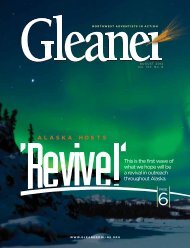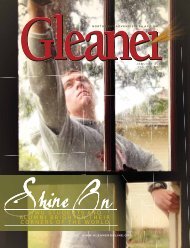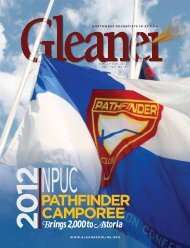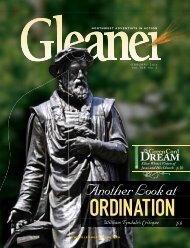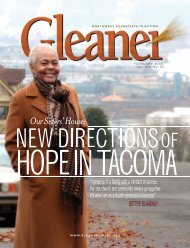Download PDF (2.3 mb) - GleanerOnline.org
Download PDF (2.3 mb) - GleanerOnline.org
Download PDF (2.3 mb) - GleanerOnline.org
You also want an ePaper? Increase the reach of your titles
YUMPU automatically turns print PDFs into web optimized ePapers that Google loves.
FEATURE<br />
1975<br />
Stereo<br />
broadcasts<br />
begin.<br />
1986<br />
New 1,000-watt<br />
transmitter<br />
installed.<br />
Transmitter moves<br />
from the Ad Building<br />
to Pikes Peak.<br />
Transmitter power<br />
increases from 1,000<br />
to 4,600 watts.<br />
1990s<br />
Last of classical<br />
programming dropped.<br />
24/7 broadcasting<br />
begins.<br />
Identity changes to<br />
Positive Life Radio.<br />
“We just got in the car and<br />
started driving. We turned on the<br />
radio to see where we could pick<br />
up the signal,” Bullock says.<br />
In 1986, continuing this trend<br />
of expanding listening area, the<br />
KGTS transmitter and antenna<br />
were moved about 12 miles away<br />
to Pikes Peak, Oregon, which is<br />
roughly 1,300 feet above average<br />
terrain. Power was also increased<br />
to 4,600 watts.<br />
The station grew in other<br />
ways too.<br />
“We started paying students,”<br />
Bullock says. As expenses went<br />
up, underwriting and listener<br />
financial support became critical<br />
to the station’s operation.<br />
FINDING THE POSITIVE<br />
FOCUS<br />
Through the end of the 1980s,<br />
KGTS continued mixed programming,<br />
but it was becoming<br />
increasingly difficult to be all<br />
things to all people.<br />
“We had multiple formats<br />
because there weren’t a lot of<br />
stations to begin with,” says<br />
Kevin Krueger, who became the<br />
current station manager in 1988.<br />
“But during a transition period<br />
we were blasted by people from<br />
all sides. Classical music lovers<br />
were asking, ‘How can you play<br />
that syrupy religious drivel?’<br />
And religious music lovers were<br />
asking, ‘How can you play that<br />
highfalutin Mozart music?’”<br />
As additional stations with<br />
competing formats entered the<br />
market, KGTS focused its programming.<br />
“We expanded midday religious<br />
music. It was unique in our<br />
coverage area, and there seemed<br />
to be a demand for it,” Krueger<br />
says. “Eventually we ended up<br />
running all-religious.”<br />
The format was well-suited<br />
to radio.<br />
“Radio is a personal medium.<br />
Most of the time you listen to it<br />
by yourself, so we approach it<br />
like we’re talking to one person,”<br />
Krueger says.<br />
January 2013 • GLEANER<br />
9





